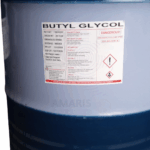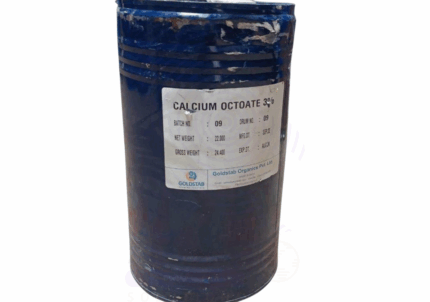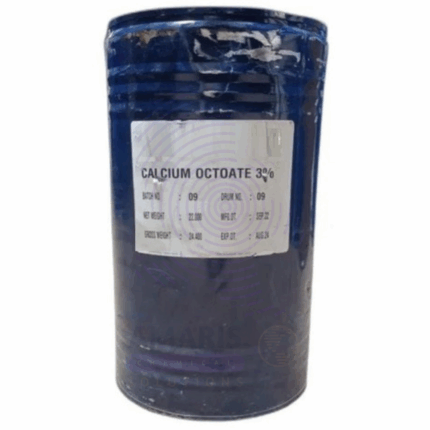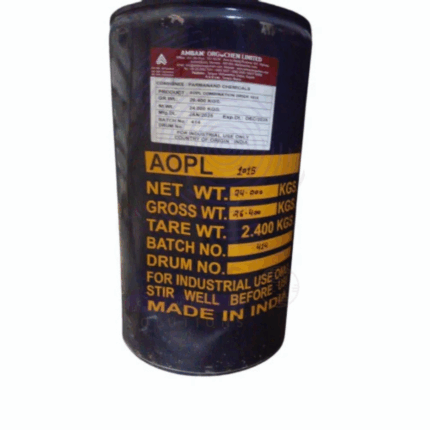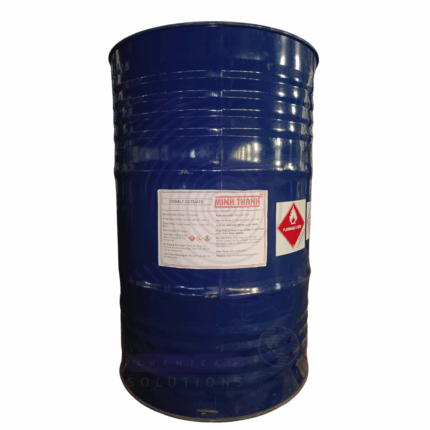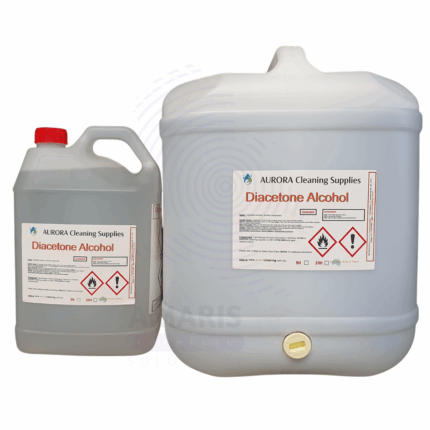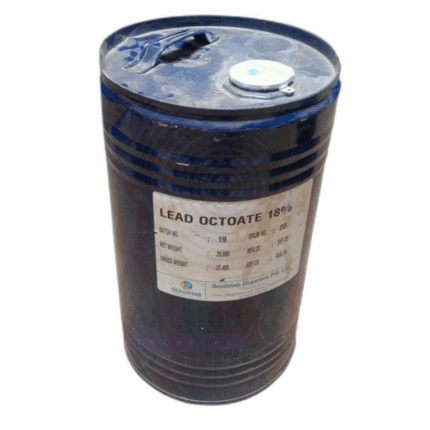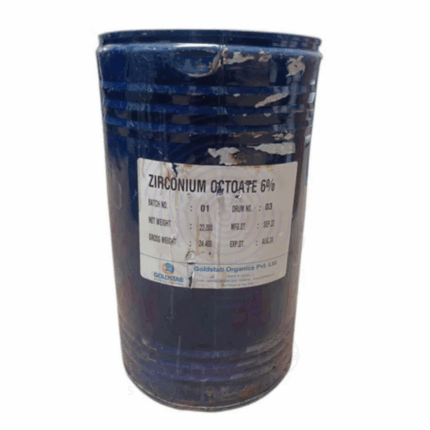Paint Drier
Whatsapp Order
Paint Drier is a specialized industrial additive designed as a non-toxic, lead-free alternative to traditional lead-based paint driers. It contains 36% active metal content primarily composed of bismuth and other metals, formulated to accelerate the drying and curing process of oil-based paints, varnishes, and coatings. The product improves film formation, reduces drying times, and enhances the durability and gloss of finished surfaces without the health and environmental hazards associated with lead compounds. BxPB36% Paint Drier is commonly used in architectural, industrial, and automotive coatings as a safer substitute for lead-based driers.
Description
Table of Contents
Toggle
Paint Drier
Primary Uses
- Paint and Coatings Industry
- Serves as a catalytic drying agent (paint drier) in alkyd, oil-based, and other solvent-based coatings.
- Enhances oxidative polymerization, enabling faster drying and curing of paints and varnishes.
- Improves surface hardness, gloss, and overall coating performance.
- Automotive and Industrial Coatings
- Used in automotive refinishing paints and industrial protective coatings to reduce downtime by accelerating dry times.
- Improves adhesion and weather resistance of coatings on metal and wood substrates.
- Architectural Paints
- Applied in house paints, stains, and lacquers to speed up drying times and improve finish quality.
Secondary Uses
- Ink Formulations
- Occasionally used as a drying catalyst in some solvent-based printing inks.
- Marine Coatings
- Utilized in specialty marine paints requiring fast drying and corrosion resistance.
- Wood Finishing
- Employed in wood varnishes and sealants to accelerate curing and enhance durability.
KEY PRODUCT FEATURES
1. Basic Identification Attributes
- Chemical Name (IUPAC): Mixed metal carboxylates (primarily bismuth-based driers)
- Common/Trade Names: BxPB36% Paint Drier, Lead Replacement Paint Drier
- CAS Number: Not a single compound; varies by formulation
- HS Code: 3811.90.90
- Molecular Formula: Mixture (varies by proprietary formulation)
- Synonyms:
- Lead-Free Paint Drier
- Bismuth-Based Paint Drier
- Non-Toxic Paint Catalyst
- Metal Carboxylate Paint Drier
2. Physical & Chemical Properties
- Physical State: Dark amber to brownish viscous liquid or solution
- Odor: Mild characteristic solvent or metal salt odor
- Boiling Point: Typically >200°C (varies by solvent base)
- Density: Approximately 1.1–1.3 g/cm³ depending on formulation
- Solubility: Soluble in oil-based solvents; insoluble in water
- pH: Not typically applicable (non-aqueous solution)
- Flash Point: Depends on solvent carrier; usually above 60°C
- Stability: Stable under recommended storage conditions; sensitive to moisture
3. Safety & Hazard Attributes
- Hazard Class (GHS):
- Flammable liquid (depending on solvent content)
- Skin and eye irritant
- NFPA Ratings:
- Health: 2
- Flammability: 2
- Reactivity: 0
- Exposure Limits: No specific metal exposure limits; handle solvents as per applicable guidelines
- Toxicity: Low toxicity; safer alternative to lead-based driers; avoid prolonged skin contact
- Reactivity: Stable; avoid strong oxidizers and moisture exposure
4. Storage & Handling Attributes
- Storage Conditions: Store in tightly sealed containers in a cool, dry, well-ventilated area away from heat and ignition sources
- Container Type: Metal or high-density polyethylene (HDPE) drums or containers resistant to solvents
- Shelf Life: 1–3 years depending on storage conditions
- Special Handling: Use protective gloves and goggles; avoid inhalation of vapors; prevent spills
5. Regulatory & Compliance Attributes
- Regulatory Status: Complies with global regulations restricting lead content in coatings
- Transportation: Classified as a flammable liquid if solvent-based; follow local and international transport regulations
- Waste Disposal: Dispose of in accordance with local environmental and hazardous waste regulations
6. Environmental & Health Impact
- Ecotoxicity: Lower environmental impact than lead-based driers; avoid release into waterways
- Persistence: Organic solvent components may biodegrade; metal carboxylates stable but low bioavailability
- Bioaccumulation: Not expected to bioaccumulate
- Carcinogenicity/Mutagenicity: Not classified as carcinogenic or mutagenic; safer than lead compounds
SAFETY HANDLING PRECAUTIONS
Safety Handling Precautions
Personal Protective Equipment (PPE):
- Chemical-resistant gloves
- Safety goggles or face shield
- Protective clothing
- Respiratory protection if ventilation is inadequate
Handling Measures:
- Avoid skin and eye contact
- Use in well-ventilated areas
- Prevent static electricity build-up during transfer
Storage Measures:
- Keep containers tightly closed
- Store away from heat, sparks, open flames, and incompatible materials
Hygiene Practices:
- Wash hands after handling
- Do not eat, drink, or smoke in work areas
First Aid Measures
- Inhalation: Move to fresh air immediately; seek medical attention if symptoms persist
- Skin Contact: Wash affected area thoroughly with soap and water; seek medical advice if irritation develops
- Eye Contact: Rinse eyes with plenty of water for at least 15 minutes; seek medical attention if irritation persists
- Ingestion: Rinse mouth; do not induce vomiting; seek immediate medical attention
Firefighting Measures
- Fire Hazards: Flammable due to solvent base; vapors may form explosive mixtures with air
- Extinguishing Media: Use foam, dry chemical, CO₂, or water spray as appropriate
- Special Precautions: Firefighters should wear full protective gear and self-contained breathing apparatus (SCBA)
- Decomposition Products: May emit toxic fumes including metal oxides and carbon monoxide during combustion
Related products
Calcium Drier
Calcium Drier is a metal-based drying agent primarily composed of calcium salts of fatty acids (commonly calcium octoate or calcium linoleate), widely used as a siccative in paints, varnishes, inks, and coatings. It functions as a catalyst to accelerate the oxidative cross-linking and polymerization of drying oils, leading to faster drying times and improved film hardness and durability. Calcium Driers are valued for their good compatibility with other driers, low toxicity, and efficient catalytic activity at low concentrations. They are commonly used alone or in combination with other metal driers such as cobalt or manganese driers for optimized drying performance.
Calcium Octoate
Calcium Octoate 10% is an aqueous solution containing 10% calcium octoate, a calcium salt of 2-ethylhexanoic acid (octanoic acid). It is a white to pale yellow liquid, soluble in water, known primarily as a metal carboxylate used as a drying agent and corrosion inhibitor. It functions as a calcium-based drier in coatings, paints, varnishes, and printing inks to accelerate the curing process by catalyzing the oxidation and polymerization of drying oils. Due to its stability and efficacy at low concentrations, it is widely preferred as a non-toxic alternative to traditional lead or cobalt-based driers.
Cobalt Drier
Cobalt Drier is a metal-based drying agent primarily composed of cobalt salts (commonly cobalt octoate or cobalt naphthenate). It is widely used as a catalyst to accelerate the drying (oxidative curing) of oils, alkyd resins, and varnishes in coatings and paints. This drier promotes polymerization and cross-linking of unsaturated fatty acids in drying oils upon exposure to air, significantly reducing drying times and improving film hardness and durability. Cobalt driers are essential additives in industrial, decorative, and automotive coatings due to their effectiveness at low concentrations and compatibility with various resin systems.
Cobalt Octoate
Cobalt Octoate is a liquid metal drying agent solution consisting of 10% cobalt octoate dissolved in an organic solvent carrier (typically mineral spirits or similar hydrocarbon solvent). It functions as a highly efficient catalyst to accelerate the oxidative curing and drying of alkyd resins, oils, and varnishes in coatings and paints. By promoting cross-linking and polymerization of unsaturated fatty acids in drying oils upon exposure to oxygen, it significantly reduces drying time and enhances film hardness, gloss, and durability. Cobalt Octoate 10% is widely used in industrial and decorative coatings, inks, and adhesives, valued for its strong catalytic activity even at low concentrations.
Di Acetone Alcohol
Di Acetone Alcohol (chemical name: 4-Hydroxy-4-methylpentan-2-one) is a clear, colorless to pale yellow liquid with a mild acetone-like odor. It is a versatile organic solvent and intermediate widely used in the manufacture of coatings, adhesives, inks, and specialty chemicals. Di Acetone Alcohol exhibits excellent solvency for resins, oils, and fats, combined with moderate evaporation rate and low volatility compared to acetone, making it suitable for controlled drying applications. It also serves as a chemical intermediate in synthesis reactions and as a component in solvent blends to optimize performance and drying characteristics.
Lead Drier
Lead Drier is a chemical additive primarily used in the coatings and paints industry to accelerate the drying and curing process of oil-based paints, varnishes, and coatings. It functions as a catalytic agent that promotes the oxidative polymerization of drying oils, reducing the drying time and improving the film formation. Lead driers are traditionally lead-based salts such as lead naphthenate or lead octoate, valued for their effectiveness at low concentrations. Due to toxicity concerns, their use is increasingly regulated and often replaced by safer alternatives.
Lead Octoate
Lead Octoate is a viscous liquid solution containing 30% lead octoate, a metal soap derived from lead and 2-ethylhexanoic acid (also known as octanoic acid). It is primarily used as a drying agent (drier) in paints, varnishes, and coatings to accelerate the curing process by promoting oxidation and polymerization of drying oils. This product is widely employed in industrial coatings to improve drying times, hardness, and durability of surface films. Packaged typically in 250kg drums, Lead Octoate 30% is handled with care due to the toxic nature of lead compounds.
Zicronium Octoate
Zicronium Octoate is a metal carboxylate solution comprising zirconium ions complexed with octoic acid at an 18% zirconium concentration. It serves as an effective crosslinking and curing agent in coatings, adhesives, and sealants, enhancing film hardness, chemical resistance, and durability. This zirconium-based additive is valued for its catalytic properties in accelerating the curing of various polymer systems, especially in automotive and industrial applications.


 Preservatives(food)
Preservatives(food) Flavor Enhancers
Flavor Enhancers Acidulants
Acidulants Sweeteners
Sweeteners Antioxidants
Antioxidants Colorants(food)
Colorants(food) Nutraceutical Ingredients (food)
Nutraceutical Ingredients (food) Nutrient Supplements
Nutrient Supplements Emulsifiers
Emulsifiers
 Collectors
Collectors Dust Suppressants
Dust Suppressants Explosives and Blasting Agents
Explosives and Blasting Agents Flocculants and Coagulants
Flocculants and Coagulants Frothers
Frothers Leaching Agents
Leaching Agents pH Modifiers
pH Modifiers Precious Metal Extraction Agents
Precious Metal Extraction Agents
 Antioxidants(plastic)
Antioxidants(plastic) Colorants (Pigments, Dyes)
Colorants (Pigments, Dyes) Fillers and Reinforcements
Fillers and Reinforcements Flame Retardants
Flame Retardants Monomers
Monomers Plasticizers
Plasticizers Polymerization Initiators
Polymerization Initiators Stabilizers (UV, Heat)
Stabilizers (UV, Heat)
 Antifoaming Agents
Antifoaming Agents Chelating Agents
Chelating Agents Coagulants and Flocculants
Coagulants and Flocculants Corrosion Inhibitors
Corrosion Inhibitors Disinfectants and Biocides
Disinfectants and Biocides Oxidizing Agents
Oxidizing Agents pH Adjusters
pH Adjusters Scale Inhibitors( water)
Scale Inhibitors( water)
 Antioxidants(cosmetic)
Antioxidants(cosmetic) Emollients
Emollients Fragrances and Essential Oils
Fragrances and Essential Oils Humectants
Humectants Preservatives
Preservatives Surfactants(cosmetic)
Surfactants(cosmetic) Thickeners
Thickeners UV Filters
UV Filters
 Fertilizers
Fertilizers Soil Conditioners
Soil Conditioners Plant Growth Regulators
Plant Growth Regulators Animal Feed Additives
Animal Feed Additives Biostimulants
Biostimulants Pesticides (Herbicides, Insecticides, Fungicides)
Pesticides (Herbicides, Insecticides, Fungicides)
 Active Pharmaceutical Ingredients (APIs)
Active Pharmaceutical Ingredients (APIs) Excipients
Excipients Solvents(pharmaceutical)
Solvents(pharmaceutical) Antibiotics
Antibiotics Antiseptics and Disinfectants
Antiseptics and Disinfectants Vaccine Adjuvants
Vaccine Adjuvants Nutraceutical Ingredients (pharmaceutical)
Nutraceutical Ingredients (pharmaceutical) Analgesics & Antipyretics
Analgesics & Antipyretics
 Analytical Reagents
Analytical Reagents Solvents(lab)
Solvents(lab) Chromatography Chemicals
Chromatography Chemicals Spectroscopy Reagents
Spectroscopy Reagents microbiology-and-cell-culture-reagents
microbiology-and-cell-culture-reagents Molecular Biology Reagents
Molecular Biology Reagents Biochemical Reagents
Biochemical Reagents Inorganic and Organic Standards
Inorganic and Organic Standards Laboratory Safety Chemicals
Laboratory Safety Chemicals Specialty Laboratory Chemicals(Special Laboratory Equipment)
Specialty Laboratory Chemicals(Special Laboratory Equipment)
 Demulsifiers
Demulsifiers Hydraulic Fracturing Fluids
Hydraulic Fracturing Fluids Scale Inhibitors(oil)
Scale Inhibitors(oil) Surfactants(oil)
Surfactants(oil) Drilling Fluids
Drilling Fluids
 Dyes and Pigments
Dyes and Pigments Bleaching Agents
Bleaching Agents Softening Agents
Softening Agents Finishing Agents
Finishing Agents Antistatic Agents
Antistatic Agents
 Admixtures
Admixtures Waterproofing Agents
Waterproofing Agents Sealants and Adhesives
Sealants and Adhesives Curing Compounds
Curing Compounds Concrete Repair Chemicals
Concrete Repair Chemicals Anti-Corrosion Coatings
Anti-Corrosion Coatings
 Surfactants(cleaning)
Surfactants(cleaning) Builders
Builders Enzymes
Enzymes Solvents (Cleaning)
Solvents (Cleaning) Fragrances
Fragrances
 Electronic Chemicals
Electronic Chemicals Catalysts
Catalysts Lubricants
Lubricants Photographic Chemicals
Photographic Chemicals Refrigerants
Refrigerants Automotive chemicals
Automotive chemicals Pyrotechnic Chemicals
Pyrotechnic Chemicals
 Biodegradable Surfactants
Biodegradable Surfactants Bio-based Solvents
Bio-based Solvents Renewable Polymers
Renewable Polymers Carbon Capture Chemicals
Carbon Capture Chemicals Wastewater Treatment Chemicals
Wastewater Treatment Chemicals
 Pigments
Pigments Solvents(paint)
Solvents(paint) Specialty Coatings
Specialty Coatings Binders/Resins
Binders/Resins Additives
Additives Driers
Driers Anti-Corrosion Agents
Anti-Corrosion Agents Functional Coatings
Functional Coatings Application-Specific Coatings
Application-Specific Coatings
 Fresh Herbs
Fresh Herbs Ground Spices
Ground Spices Whole Spices
Whole Spices Spice Blends
Spice Blends Dried Herbs
Dried Herbs
 Leavening Agents
Leavening Agents Dough Conditioners
Dough Conditioners Flour Treatments
Flour Treatments Fat Replacers
Fat Replacers Decoratives
Decoratives Preservatives(baking)
Preservatives(baking)
 Plasticizers & Softeners
Plasticizers & Softeners Reinforcing Agents
Reinforcing Agents Adhesion Promoters
Adhesion Promoters Vulcanizing Agents
Vulcanizing Agents Antidegradants
Antidegradants Blowing Agents
Blowing Agents Fillers & Extenders
Fillers & Extenders Accelerators & Retarders
Accelerators & Retarders
